5A Photosynthesis and Respiration
1/33
Earn XP
Description and Tags
Name | Mastery | Learn | Test | Matching | Spaced |
|---|
No study sessions yet.
34 Terms
What do plants use energy for? What else might animals use it for?
Photosynthesis, active transport, DNA replication, cell division, protein synthesis.
Animals also need it for muscle contraction and maintenance of body temperature.
What is the overall symbol equation of photosynthesis?
6CO₂ + 6H₂O → C₆H₁₂O₆ + 6O₂
the reaction uses light energy
How is energy released from the glucose produced by photosynthesis?
Respiration.
What are the two types of respiration and what is the overall equation?
Aerobic and anaerobic.
C₆H₁₂O₆ + 6O₂ → 6CO₂ + 6H₂O + energy
What is the product of anaerobic respiration in plants and yeast cells?
ethanol and carbon dioxide
What is the product of anaerobic respiration in animals?
Lactate
Why is ATP good for energy storage?
it releases only small amounts of energy at a time so no energy is wasted.
It’s small and soluble and so can be easily transported around the cell.
It’s easily broken down so energy can be released instantaneously.
It can be easily remade.
It can make other molecules more reactive through phosphorylation.
It can’t pass out of the cell.
What is a coenzyme?
A molecule that aids the function of an enzyme by transferring a chemical group from one molecule to another. In photosynthesis, NADP is used and transfers hydrogen from one molecule to another.
Name 3 photosynthetic pigments found in chloroplasts. What name is given to them and the protein they attach to?
Chlorophyll A, Chlorophyll B and carotene.
The photostem.
Describe the light-dependent reaction of photosynthesis.
Energy is absorbed by the chlorophyll in photostems in the thylakoid membrane. The light energy excites electrons in the chlorophyll and the electrons are triggered to release.
The chlorophyll has been photoionised.
The high-energy electrons move along the carriers of an electron transfer chain and release energy as they go. This energy is used to actively pump protons from the stroma into the thylakoid space.
These protons then move down a photochemical gradient by facilitated diffusion back into the stroma via an ATP Synthase enzyme. This process is called chemiosmosis and it provides energy to synthesise ATP from ADP and Pi.
The electrons in the transfer chain reduce NADP using protons from the stroma. NADPH is formed.
Water is split due to photoionisation in a process called photolysis. Electrons, oxygen and protons are produced. The electrons replace the electrons lost by the chlorophyll, the oxygen diffuses out as a waste product and the protons will contribute to chemiosmosis or reduce NADP.
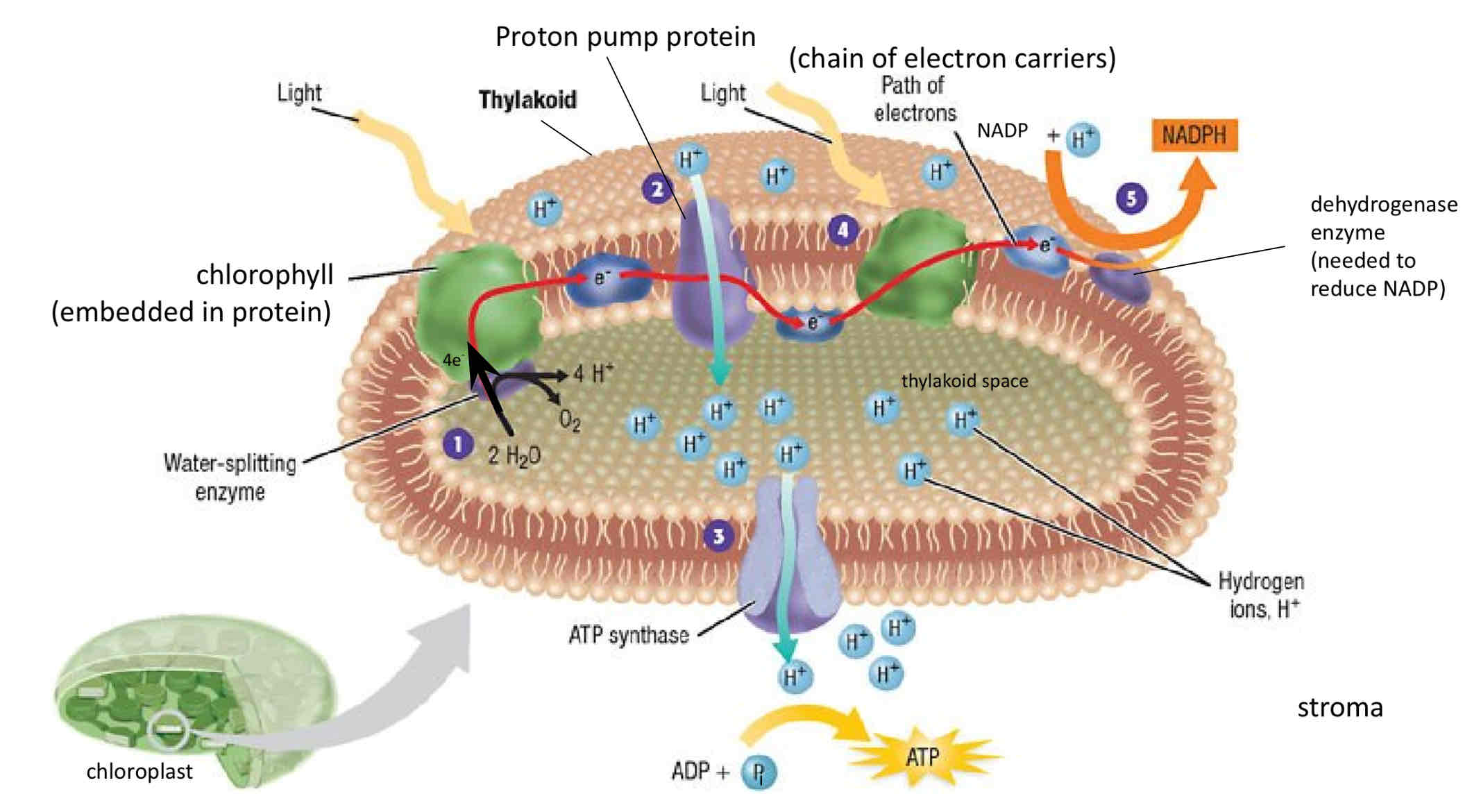
What 3 things is the energy from the photoionisation of chlorophyll used for in the light dependent reaction?
photophosphorylation- making ATP from ADP and Pi
Making NADPH from NADP
Photolysis- splitting water into protons, electrons and oxygen.
Which chemicals are needed for the light-dependent reaction?
NADP, ADP, Pi and water
Where does the light-independent reaction take place in the chloroplast?
the stroma
What is the light independent reaction also known as?
The Calvin Cycle
What are the steps of the Calvin Cycle?
carbon dioxide reacts with ribulose biphosphate (RuBP) to form two molecules of glycerate 3-phosphate (GP). This reaction is catalysed by rubisco.
Reduced NADP from the light dependent reaction is used to reduce GP to triose phosphate; energy for this is provided by ATP.
Some triose phosphate can be used to regenerate RuBP and complete the cycle. This also requires energy from ATP.
Some triose phosphate is converted to useful organic substances like glucose.
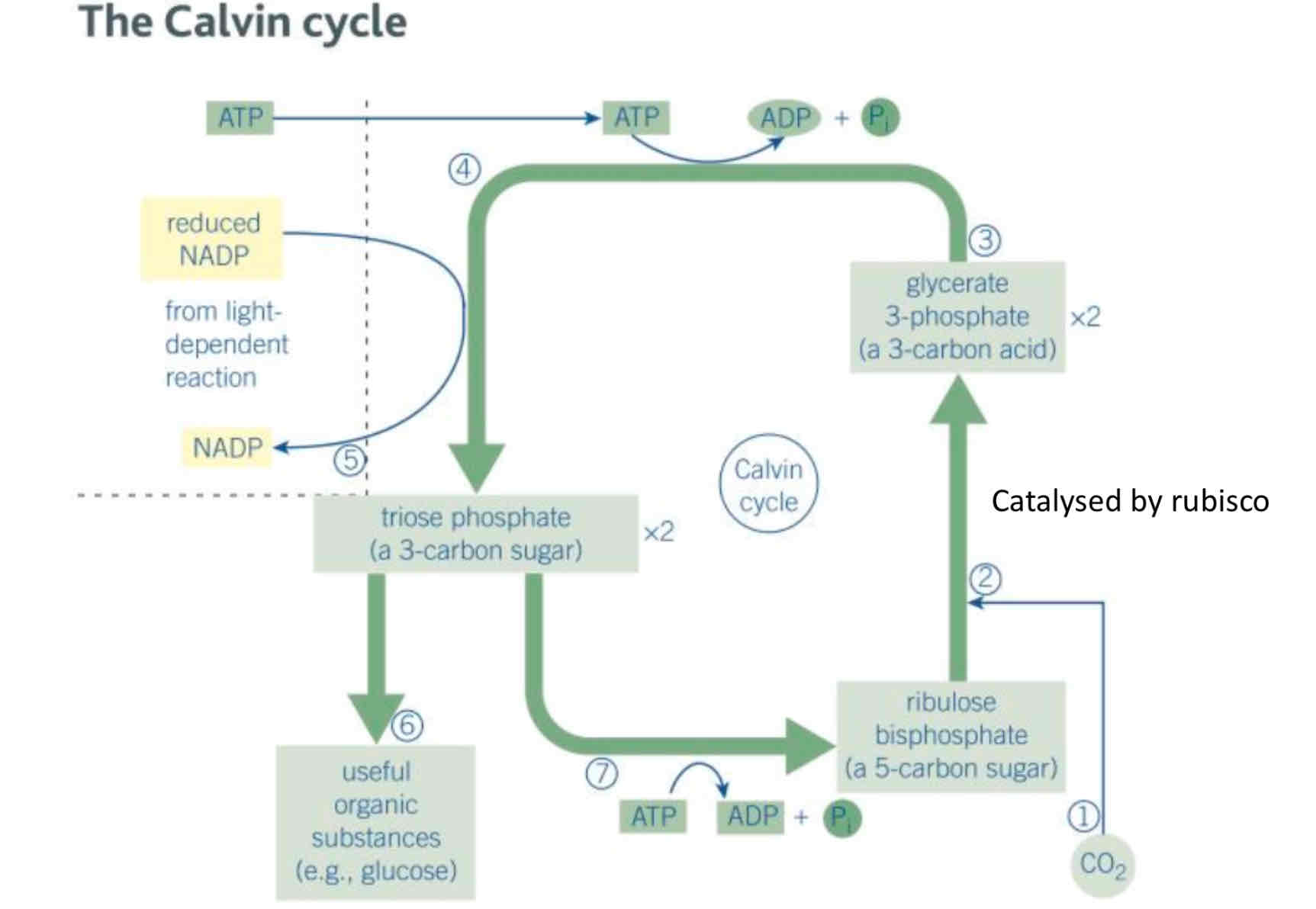
Why might something that inhibits the light dependent reaction - eg. By affecting the electron transfer chain- kill a plant?
Less/no ATP or NADPH produced in the light dependent reaction so GP cannot be reduced in the light independent reaction and no triose phosphate is formed. No glucose is formed and there is no glucose to be used in respiration.
Why might plants have more photosynthetic pigments than just chlorophyll?
To allow a wider range of wavelengths of light to be absorbed, increasing the rate of photosynthesis as there will be more energy for the light dependent reaction.
Describe glycolysis.
The first stage of both aerobic and anaerobic respiration. It occurs in the cytoplasm and is anaerobic.
Activation of glucose by phosphorylation- glucose is converted into glucose phosphate using ATP. (X2 ATP USED)
Splitting- glucose phosphate is split into two molecules of triose phosphate.
Oxidation- triose phosphate is oxidised into pyruvate and NAD is reduced into NADH (X4 ATP MADE- net gain in ATP)
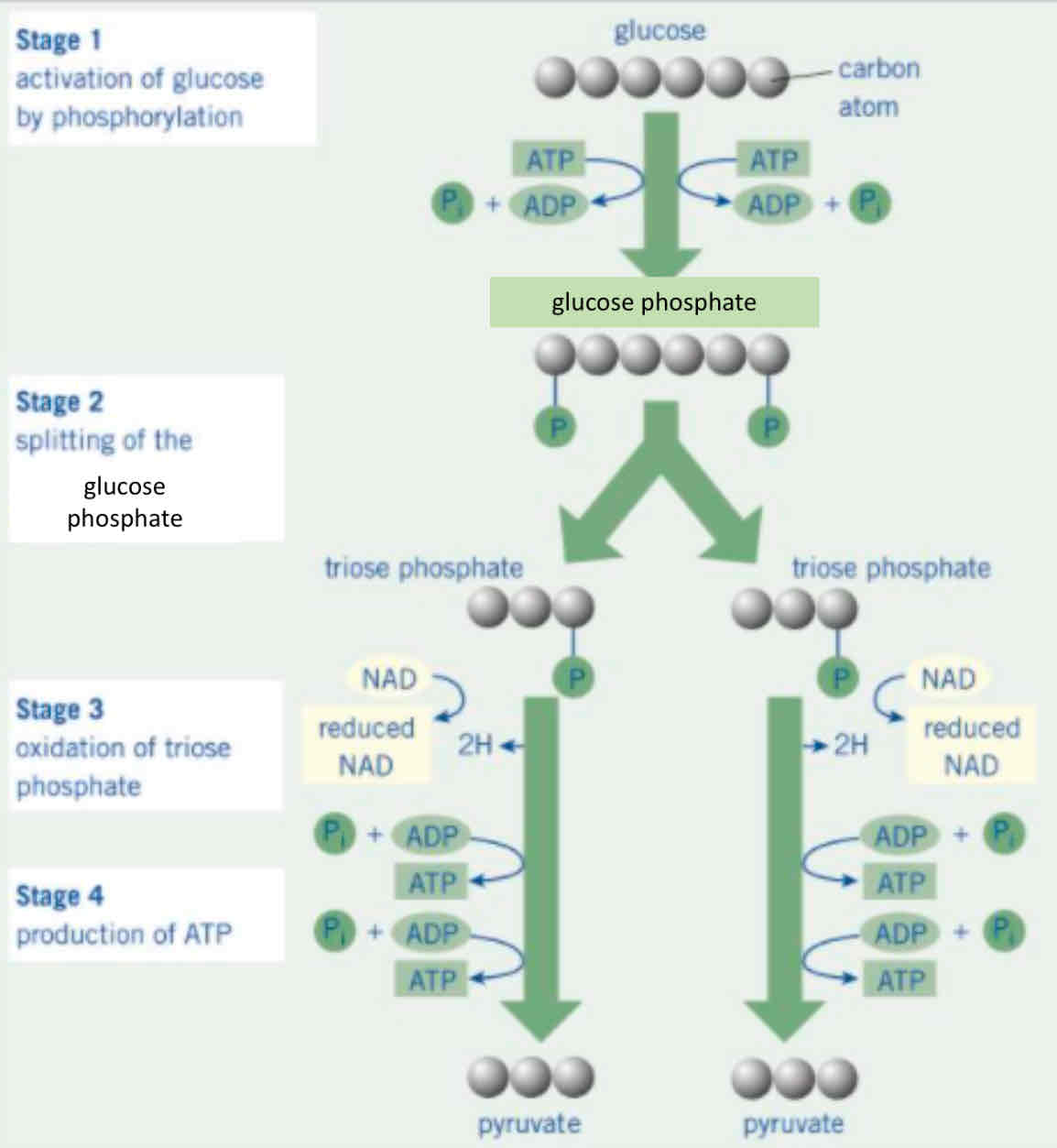
What is substrate-level phosphorylation?
When a phosphate group is transferred from a substrate molecule to ADP to produce ATP. It is the method of producing ATP in both glycolysis and the Krebs Cycle. (Does not require ATP synthase)
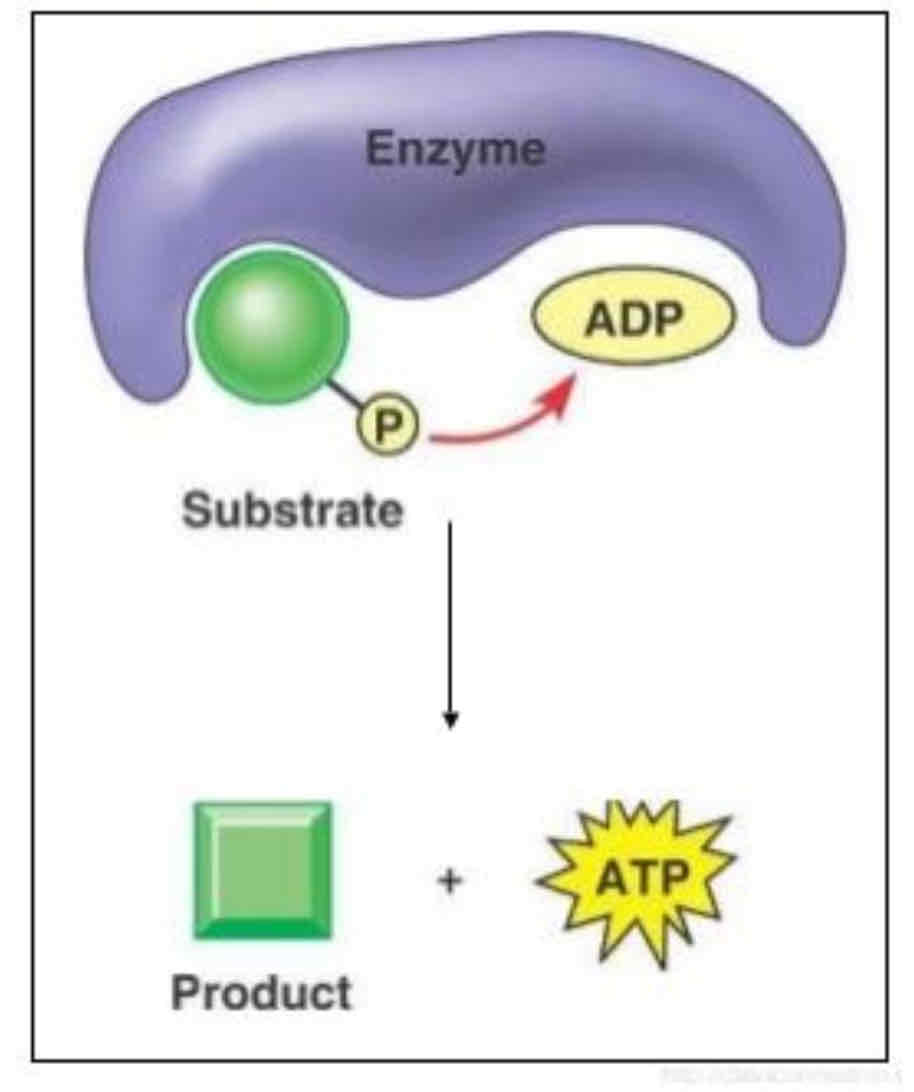
Describe the process of anaerobic respiration in plants and fungi (via ethanol production).
Glycolysis produces NADH, pyruvate and a net gain of ATP.
Pyruvate is reduced to ethanol using hydrogen from the NADH. Carbon dioxide is also formed.
The NAD produced can be used in further glycolysis.
Give the equation for anaerobic respiration of plants and fungi via ethanol production.
Pyruvate + NADH → ethanol + NAD + carbon dioxide
Describe anaerobic respiration in animals via lactate production.
Glycolysis produces NADH, pyruvate and a net gain of ATP.
Pyruvate is reduced to lactate using hydrogen from NADH
NAD can be used in further glycolysis, no CO₂ is produced.
Give the equation for anaerobic respiration in animals via lactate production.
Pyruvate + NADH → lactate + NAD
How does lactate lead to muscle fatigue?
Causes a drop in pH that inhibits enzymes
What is the equation for aerobic respiration?
Glucose + oxygen → Carbon dioxide + water
What are the four stages of aerobic respiration?
1) glycolysis
(Pyruvate enters the mitochondrion)
2) link reaction
3) Krebs cycle
4) oxidative phosphorylation
What is the link reaction?
The second part of aerobic respiration, the first to take place in the mitochondrial matrix.
Pyruvate is oxidised to acetate, forming NADH and carbon dioxide in the process.
Acetate combines with coenzyme A to produce acetylcoenzyme A
Give the two equations of the link reaction.
Pyruvate + NAD→ Acetate + NADH + carbon dioxide
Acetate + coenzyme A→ Acetylcoenzyme A
Describe the Krebs Cycle.
Takes place in the mitochondrial matrix,
acetylcoenzyme A reacts with a four-carbon molecule, releasing coenzyme A and producing a six-carbon molecule that enters the Krebs Cycle.
The Krebs Cycle generates NADH, FADH, ATP and CO₂ as well as the four-carbon molecule to begin the cycle again.
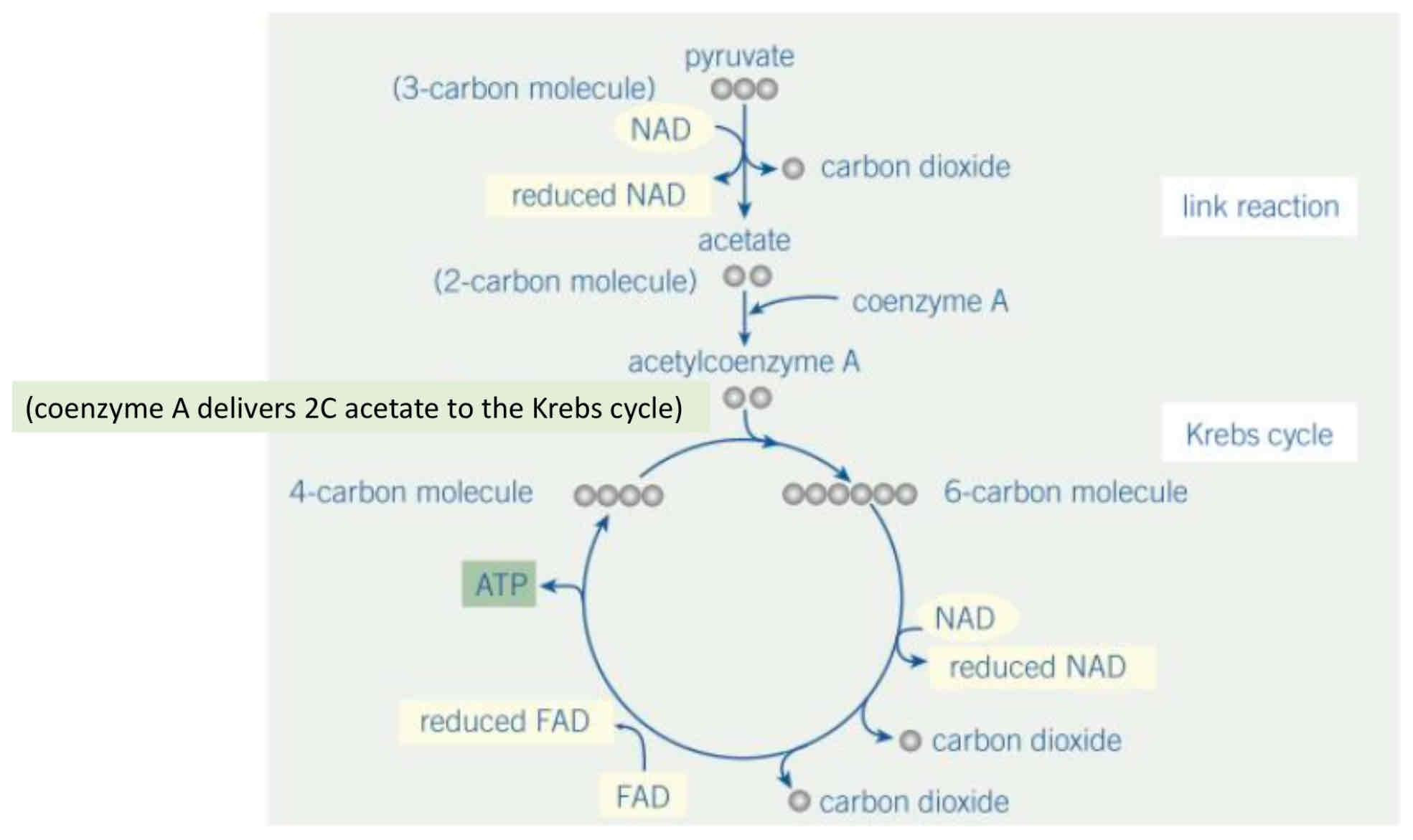
Describe oxidative phosphorylation.
The last stage of aerobic respiration, taking place in the inner mitochondrial membrane.
NADH and FADH are oxidised to release protons and high-energy electrons. The electrons enter the electron transfer chain in the inner mitochondrial membrane.
The electrons are passed along the chain and release energy that is used to actively pump protons against their electrochemical gradient into the intermembrane space from the matrix.
The protons then move by facilitated diffusion through a channel via ATP synthase in the inner membrane back into the matrix. This is chemiosmosis.
In doing so, the protons release energy that causes the ATP synthase to catalyse the formation of ATP from ADP and Pi.
At the end of the transfer chain, electrons and protons are used to reduce oxygen to water.
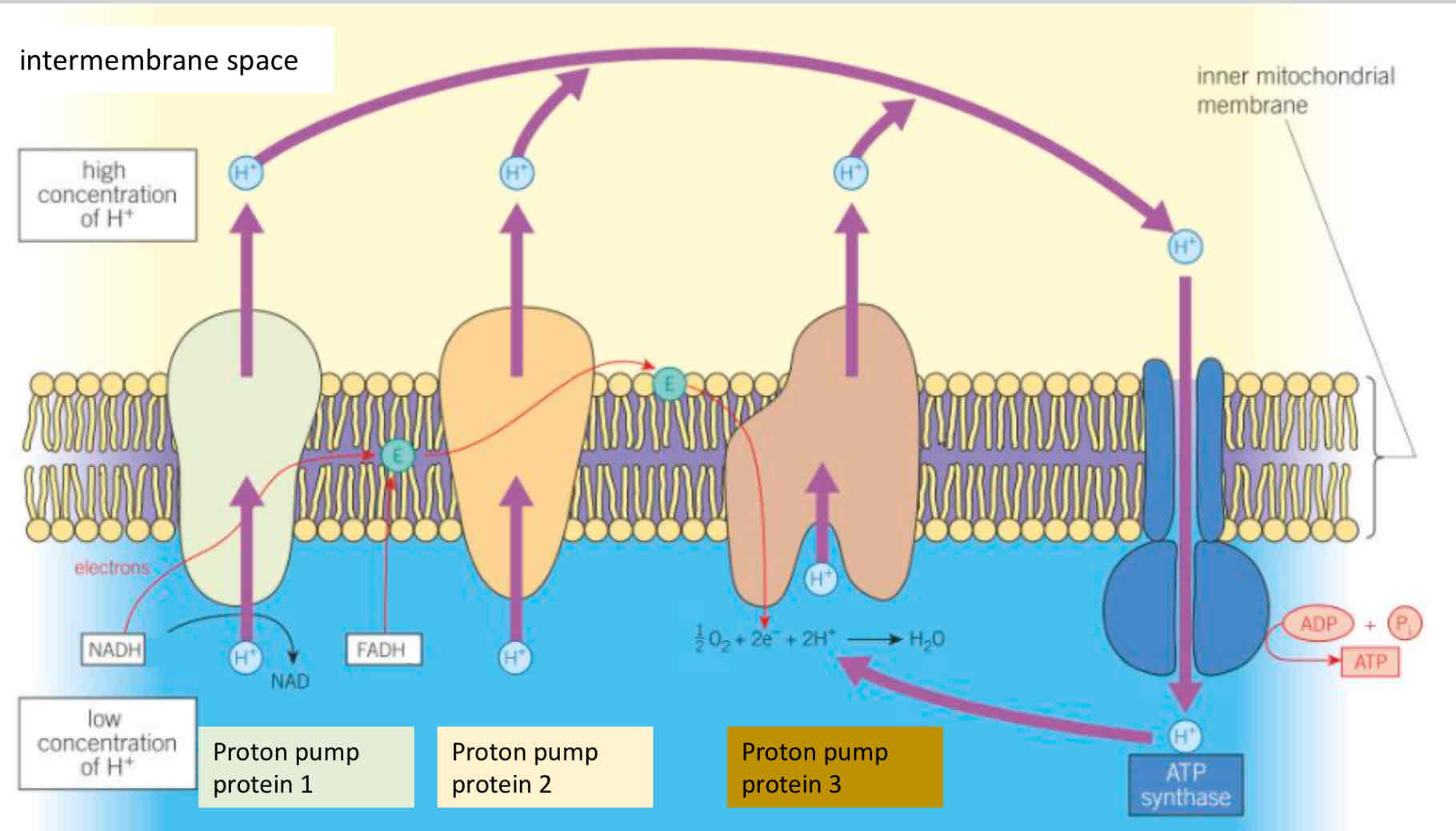
What is the final electron acceptor of the transfer chain in oxidative phosphorylation?
Oxygen
What is the advantage of red blood cells having no mitochondria?
More space for haemoglobin; no aerobic respiration possible so oxygen cannot be used up on the way to the cells.
How can lipids be respired?
triglycerides are hydrolysed into glycerol and fatty acids,
Glycerol is converted into triose phosphate which then goes into glycolysis,
Fatty acids are transported into the mitochondria where they are broken down into many acetate molecules. These are then converted into acetylcoenzyme A for the Krebs Cycle,
There is therefore a large number of acetylcoenzyme A molecules per triglyceride, so there is lots of NADH and FADH for use in oxidative phosphorylation. Large amounts of ATP can be made.
How can proteins be respired?
Proteins are hydrolysed into amino acids.
Amino acids have one amine group removed.
The remaining organic compound is respired via the Krebs Cycle.
This is a last resort as proteins have many other uses in an organism.